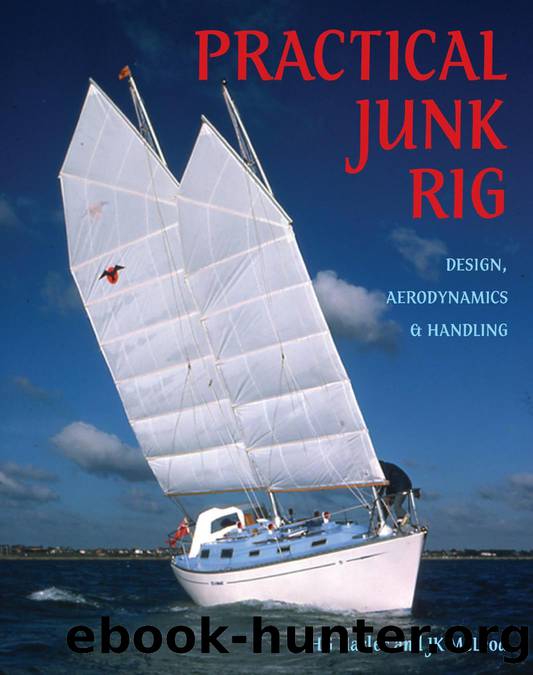Practical Junk Rig by Hasler H. G.;McLeod J. K.;

Author:Hasler, H. G.;McLeod, J. K.;
Language: eng
Format: epub
Publisher: Bloomsbury Publishing Plc
Published: 2019-12-06T00:00:00+00:00
8 Masts
For reasons set out on p 13, we are considering only unstayed (cantilever) masts that stand up without any shrouds, forestays, or backstays. They are supported laterally at the partners (where the mast emerges from the deck or coachroof) and the step (where the heel of the mast is held fixed, usually to the keelson).
The main stresses in these masts are bending loads, made up of the largely static forces induced by the wind in the sail and the dynamic forces induced by the rolling and pitching of the boat.
When the sail is on the lee side of the mast the wind forces act as in Fig. 8.1, which shows the sail in section. The parrels distribute the load fairly evenly up the mast. On the other tack the yard, battens, and boom will press against the mast and the parrels will be slack, but the distribution of forces will be similar.
Considering only the loading of the mast, if the sum of the sail forces is taken as F, and if P and S are taken as the lateral forces induced in the partners and step respectively, then the partners may be regarded as a fulcrum and force S will be such that the moment S Ã B (B is the bury) equals F Ã H. The greater the bury (B) the less the forces of P and S. Force P is the sum of F and S.
In strong winds, most boats can carry more sail when running than when on the wind, and this may be the point of sailing that develops maximum mast loading. It also develops maximum batten loadings (see p 14).
The dynamic forces induced by the weight of the mast when the boat is rolling or pitching are similar. If no sail is set, reversing forces at P and S are induced when the movement of the hull waggles the mast about. If sail is set, its weight increases these forces and its air resistance, even in a flat calm, can set up additional loadings. Every seaman knows the severe forces set up in a rig when the boat rolls heavily in a swell and the sail snatches against the sheets, first one way and then the other. For these reasons the partners and step should be designed to take lateral loads in any direction.
Download
This site does not store any files on its server. We only index and link to content provided by other sites. Please contact the content providers to delete copyright contents if any and email us, we'll remove relevant links or contents immediately.
| Aerodynamics | Aircraft Design & Construction |
| Astronautics & Space Flight | Avionics |
| Gas Dynamics | Propulsion Technology |
Whiskies Galore by Ian Buxton(41937)
Introduction to Aircraft Design (Cambridge Aerospace Series) by John P. Fielding(33092)
Small Unmanned Fixed-wing Aircraft Design by Andrew J. Keane Andras Sobester James P. Scanlan & András Sóbester & James P. Scanlan(32764)
Craft Beer for the Homebrewer by Michael Agnew(18196)
Turbulence by E. J. Noyes(7977)
The Complete Stick Figure Physics Tutorials by Allen Sarah(7338)
Kaplan MCAT General Chemistry Review by Kaplan(6899)
The Thirst by Nesbo Jo(6877)
Bad Blood by John Carreyrou(6581)
Modelling of Convective Heat and Mass Transfer in Rotating Flows by Igor V. Shevchuk(6406)
Learning SQL by Alan Beaulieu(6237)
Weapons of Math Destruction by Cathy O'Neil(6214)
Man-made Catastrophes and Risk Information Concealment by Dmitry Chernov & Didier Sornette(5956)
Digital Minimalism by Cal Newport;(5704)
Life 3.0: Being Human in the Age of Artificial Intelligence by Tegmark Max(5514)
iGen by Jean M. Twenge(5385)
Secrets of Antigravity Propulsion: Tesla, UFOs, and Classified Aerospace Technology by Ph.D. Paul A. Laviolette(5333)
Design of Trajectory Optimization Approach for Space Maneuver Vehicle Skip Entry Problems by Runqi Chai & Al Savvaris & Antonios Tsourdos & Senchun Chai(5037)
Pale Blue Dot by Carl Sagan(4953)
